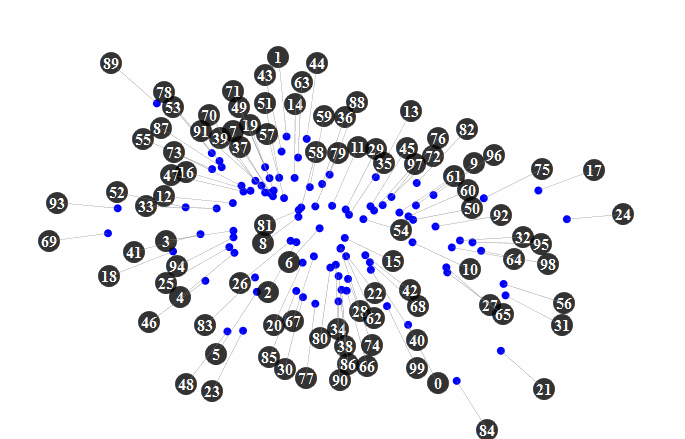D3 を使用して、フローティング ラベル付きの円グラフを作成しようとしています。私はD3が初めてで、これが可能かどうかさえわかりませんか? あるグラフのラベルを別のグラフで使用できますか? もしよろしければ、例を挙げていただけませんか?
短い説明: ラベルが欲しい: http://bl.ocks.org/1691430
 ...円グラフになります。
...円グラフになります。
以下は私が実行していたコードです: または JSBIN: http://jsbin.com/awilak/1/edit
彼のコードを正しく理解していれば、これはラベルを追加するセクションです。labelForce.update の機能がわかりません。そこからは遷移は気にしないので、その線はいらないです。残りは円を描いてリンク/ラインを追加するだけですか?誰かがそれを統合できれば素晴らしいですが、何が起こっているのか、何が欠けているのかを理解するのを手伝ってくれれば、私はとても感謝しています.
// Now for the labels
// This is the only function call needed, the rest is just drawing the labels
anchors.call(labelForce.update)
labels = svg.selectAll(".labels")
.data(data, function(d,i) {return i;})
labels.exit()
.attr("class","exit")
.transition()
.delay(0)
.duration(500)
.style("opacity",0)
.remove();
// Draw the labelbox, caption and the link
newLabels = labels.enter().append("g").attr("class","labels")
newLabelBox = newLabels.append("g").attr("class","labelbox")
newLabelBox.append("circle").attr("r",11)
newLabelBox.append("text").attr("class","labeltext").attr("y",6)
newLabels.append("line").attr("class","link")
labelBox = svg.selectAll(".labels").selectAll(".labelbox")
links = svg.selectAll(".link")
labelBox.selectAll("text").text(function(d) { return d.num})
}
<!DOCTYPE html>
<html>
<head>
<meta http-equiv="Content-type" content="text/html; charset=utf-8">
<title>Testing Pie Chart</title>
<script type="text/javascript" src="http://mbostock.github.com/d3/d3.js?2.1.3"></script>
<script type="text/javascript" src="http://mbostock.github.com/d3/d3.geom.js?2.1.3"></script>
<script type="text/javascript" src="http://mbostock.github.com/d3/d3.layout.js?2.1.3"></script>
<style type="text/css">
.slice text {
font-size: 16pt;
font-family: Arial;
}
</style>
</head>
<body>
<button id="button"> Test </button>
<br>
<form id="controls">
<div>
<h2>Y axis</h2>
<ul id="y-axis">
<li><label><input checked="checked" type="radio" name="y-axis" value="Component">Component</label></li>
<li><label><input type="radio" name="y-axis" value="Browser">Browser</label></li>
<li><label><input type="radio" name="y-axis" value="Version">Version</label></li>
</ul>
</div>
</form>
<script type="text/javascript">
// return a list of types which are currently selected
function plottableTypes () {
var types = [].map.call (document.querySelectorAll ("#coaster-types input:checked"), function (checkbox) { return checkbox.value;} );
return types;
}
var w = 600, //width
h = 600, //height
r = 100,
r2 = 200, //radius
axis = getAxis (), //axes
color = d3.scale.category20c(); //builtin range of colors
data = [
{"Browser":"Internet Explorer ","Version":"8.0","Toatl":2000,"Component":"6077447412293130422"},
{"Browser":"Internet Explorer ","Version":"9.0 ","Toatl":1852,"Component":"6077447412293130422"},
{"Browser":"Internet Explorer ","Version":"6.0 ","Toatl":1754,"Component":"6077447412293130422"},
{"Browser":"Firefox ","Version":"16.0 ","Toatl":1020,"Component":"6077447412293130422"},
{"Browser":"Chrome ","Version":"23.0 ","Toatl":972,"Component":"6077447412293130422"},
{"Browser":"Internet Explorer ","Version":"7.0 ","Toatl":700,"Component":"6077447412293130422"},
{"Browser":"Mobile Safari ","Version":"6.0 ","Toatl":632,"Component":"6077447412293130422"},
{"Browser":"BOT ","Version":"BOT ","Toatl":356,"Component":"6077447412293130422"},
{"Browser":"Firefox ","Version":"8.0 ","Toatl":196,"Component":"6077447412293130422"},
{"Browser":"Mobile Safari ","Version":"5.1 ","Toatl":184,"Component":"6077447412293130422"}
];
var vis = d3.select("body")
.append("svg:svg") //create the SVG element inside the <body>
.data([data]) //associate our data with the document
.attr("width", w) //set the width and height of our visualization (these will be attributes of the <svg> tag
.attr("height", h)
.append("svg:g") //make a group to hold our pie chart
.attr("transform", "translate(" + r2 + "," + r2 + ")") //move the center of the pie chart from 0, 0 to radius, radius
var arc = d3.svg.arc() //this will create <path> elements for us using arc data
.outerRadius(r);
var pie = d3.layout.pie() //this will create arc data for us given a list of values
.value(function(d) { return d.Toatl; }); //we must tell it out to access the value of each element in our data array
var arcs = vis.selectAll("g.slice") //this selects all <g> elements with class slice (there aren't any yet)
.data(pie) //associate the generated pie data (an array of arcs, each having startAngle, endAngle and value properties)
.enter() //this will create <g> elements for every "extra" data element that should be associated with a selection. The result is creating a <g> for every object in the data array
.append("svg:g") //create a group to hold each slice (we will have a <path> and a <text> element associated with each slice)
.attr("class", "slice"); //allow us to style things in the slices (like text)
arcs.append("svg:path")
.attr("fill", function(d, i) { return color(i); } ) //set the color for each slice to be chosen from the color function defined above
.attr("d", arc); //this creates the actual SVG path using the associated data (pie) with the arc drawing function
arcs.append("svg:text") //add a label to each slice
.attr("transform", function(d) { //set the label's origin to the center of the arc
//we have to make sure to set these before calling arc.centroid
d.innerRadius = r2;
d.outerRadius = r;
return "translate(" + arc.centroid(d) + ")"; //this gives us a pair of coordinates like [50, 50]
})
.attr("text-anchor", "middle") //center the text on it's origin
.text(function(d, i) {
if(axis.yAxis == "Component"){
return data[i].Component;
}
return data[i].Browser; //get the label from our original data array
});
d3.select('#button').on('click', reColor);
var arcOver = d3.svg.arc()
.outerRadius(r + 30)
.innerRadius(0);
var arc = d3.svg.arc()
.outerRadius(r)
.innerRadius(0);
var arcs = vis.selectAll("g.slice")
.attr("class", "slice")
.on("mouseover", function(d) {
getAxis();
d3.select(this)
.select("path")
.transition()
.duration(500)
.attr("d", arcOver);
d3.select(this).select("text")
.text(function(d, i) {
if(axis.yAxis == "Component"){
return data[i].Component;
}
return data[i].Browser; //get the label from our original data array
});
})
.on("mouseout", function(d) {
getAxis();
d3.select(this)
.select("path")
.transition()
.duration(500)
.attr("d", arc);
d3.select(this)
.select("text")
.text(function(d, i) {
if(axis.yAxis == "Component"){
return data[i].Component;
}
return data[i].Browser; //get the label from our original data array
});
});
function reColor(){
var slices = d3.select('body').selectAll('path');
slices.transition()
.duration(2000)
.attr("fill", function(d, i) { return color(i+2); } );
slices.transition()
.delay(2000)
.duration(2000)
.attr("fill", function(d, i) { return color(i+10); } )
}
function makeData(){
}
// return an object containing the currently selected axis choices
function getAxis () {
var y = document.querySelector("#y-axis input:checked").value;
return {
yAxis: y,
};
}
function update() {
axis = getAxis()
arcs.selectAll("text") //add a label to each slice
.text(function(d, i) {
if(axis.yAxis == "Component"){
return data[i].Component;
}
return data[i].Browser; //get the label from our original data array
});
}
document.getElementById("controls").addEventListener ("click", update, false);
document.getElementById("controls").addEventListener ("keyup", update, false);
</script>
</body>
</html>